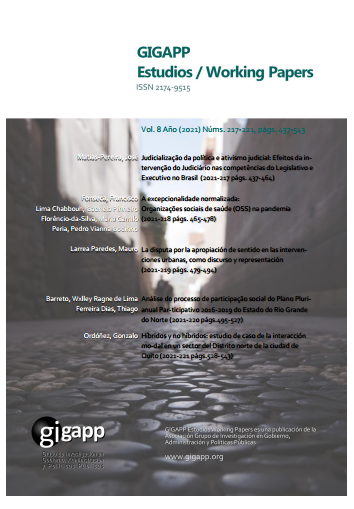Hybrids and non-hybrids: case study of the modal interaction in a sector of the northern district of the city of Quito
Abstract
The incidence and expansion of virtual interaction, through social networks, affects all generations, but not in the same way, older adults and young people show similarities, such as the use of chat to interact with their close ones, but also differences that fundamentally they have to do with the way of face-to-face interaction. Older adults have segmented behavior in the use and type of social network, associated with their preference for face-to-face interaction, which comes from their generational experience. Young people combine the two modes of interaction permanently, with the chat as its axis, in comparison to the use of voice calls that are kept low, which demonstrates a hybrid behavior in which the two spaces overlap (virtual and face to face), but at the cost of a breakdown in the attention that the face to face demands.
Downloads
References
Cambra, U. C. (2013). Fundamentos psicosociales de la reputación «online»: Propuesta de un modelo y un caso de análisis. Estudios sobre el Mensaje Periodístico, 19(0), 691-700-700. https://doi.org/10.5209/rev_ESMP.2013.v19.42152
Fernández, M. C. S., & Alcalde, J. B. F. (2015). No, sin mi móvil. Diferencias de género y uso de las nuevas tecnologías. Icono14, 13(1), 14.
Goffman, E. (2007). La presentación de la persona en la vida cotidiana. Buenos Aires: Amorrortu.
Goffman, E., & Rodríguez, J. L. (2006). Frame analysis: Los marcos de la experiencia. Madrid: Centro de Investigaciones Sociológicas.
Joseph, I. (1999). Erving Goffman y la microsociología. Barcelona: Gedisa.
Marc, E., Picard, D., & Laje Tesouro, A. (1992). La interacción social: Cultura, instituciones y comunica-ción. Barcelona: Paidos.
Martínez, D. A. (2017). Inmersión, Interfaz y Objetos Liminares. Cuadernos de Información y Comunica-ción; Madrid, 22, 127-156. http://dx.doi.org/10.5209/CIYC.55971
Restak, R. M. (2005). Nuestro Nuevo Cerebro (1st. edition). Barcelona: Ediciones Urano.
Tascón, M. (dir ). (s. f.). Escribir en Internet: Guía para los nuevos medios y las redes sociales. Recuperado de http://www.digitaliapublishing.com/a/28866/escribir-en-internet---guia-para-los-nuevos-medios-y-las-redes-sociales
Turkle, S., & Roca, J. E. (2017). En defensa de la conversación: El poder de la conversación en la era digital. Barcelona: Ático de los Libros.
Vilte, D., Saldaño, V., Martín, A., & Gaetán, G. (2014). Evaluación del Uso de Redes Sociales en la Tercera Edad. 9.
Copyright (c) 2021 Gonzalo Ordóñez (Autor/a)

This work is licensed under a Creative Commons Attribution-NonCommercial-ShareAlike 4.0 International License.
Those authors who have publications with this journal, accept the following terms:
a. Authors will retain their copyrights and guarantee the journal the right of first publication of their work, which will be simultaneously subject to the Creative Commons Attribution-NonCommercial-ShareAlike 4.0 International (CC BY-NC-SA Recognition License). 4.0) that allows third parties to share the work as long as its author and its first publication are indicated in this journal.
Under this open access license, readers (users) can:
- Share — copy and redistribute the material in any medium or format
- Adapt — remix, transform, and build upon the material
Under the following terms:
-
Attribution — Users must give appropriate credit, provide a link to the license, and indicate if changes were made. You may do so in any reasonable manner, but not in any way that suggests the licensor endorses you or your use.
-
NonCommercial — Users may not use the material for commercial purposes.
-
ShareAlike — If remix, transform, or build upon the material, users must distribute your contributions under the same license as the original.
- No additional restrictions — Users may not apply legal terms or technological measures that legally restrict others from doing anything the license permits.
b. Authors may adopt other non-exclusive license agreements for the distribution of the version of the published work (eg: deposit it in an institutional telematic archive or publish it in a monographic volume) provided that the initial publication in this journal is indicated.
c. Authors are allowed and recommended to disseminate their work through the Internet (e.g. in institutional telematic files or on their website) before and during the submission process, which can lead to interesting exchanges and increase citations of the published work. (See The effects of open access).



